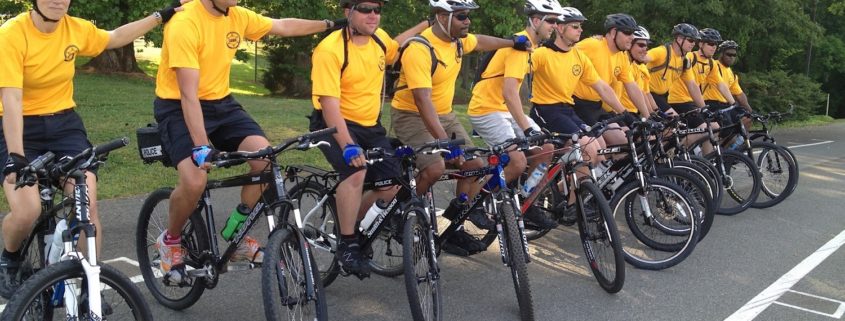Basic Course
Class B Course
Class B certification will only be granted if a minimum of 24-hours, or three consecutive days of mountain bike training covering the following areas of instruction are given, and the student successfully passes a written and practical examination on these areas. Cardiovascular fitness for the police officer including target heart rate.
- Nutrition for the mountain bike officer.
- Cholesterol explanation and N.C.E.P. guidelines
- Saddle, knee, hand, and foot injuries.
- Stretching.
- Slow speed balance drills.
- Hypothermia and dehydration.
- Effective Cycling video and lecture.
- Training rides. (minimum of three)
- Accident prevention for the mountain bike officer.
- Safety equipment, uniforms, and accessories.
- Proper bicycle fit.
- Emergency braking.
- Gears and cadence.
- Police technical skills: Cross-over Drills©, Cross-Over Exit©, Cross-Over Take-down©, Powerslide Exit©, Push off Cross-Over©, Kickstand Exit©, and Look over Drill©.
- LEBA written examination consisting of 25 questions minimum.
Students must pass the written examination by a score of 70%. Practical exercises must be successfully performed and passed to the satisfaction of the Instructor(s) teaching the course. Students must: be able to successfully “Exit” the mountain bike safely and quickly, be able to demonstrate a full emergency braking using the front brake only, the rear brake only, and both brakes, demonstrate a safe and quick simulated arrest of a suspect on foot, and complete training rides using effective cycling techniques to pass this course
Class C Certification Course (Security and Medic)
Class C certification will only be granted if a minimum of 16-hours, or two consecutive days of mountain bike training covering the following areas of instruction are given, and the student successfully passes a written and practical examination on these areas. Cardiovascular fitness and target heart rate, and overview.
- Body fuels and exercise.
- Mountain bike nomenclature and fit.
- Prevention of common cycling injuries.
- Effective Cycling video.
- Training rides. (minimum of two)
- Suspect Contact video.
- Gears and cadence.
- Stretching.
- Balance drills.
- Police technical skills: Cross-over Drills©, Cross-Over Exit©, Cross-Over Take-down©, Powerslide Exit©, Push off Cross-Over©, Kickstand Exit©, and Look over Drill©.
Students attending a Class C course must pass the course by successfully passing practical portions of the training to the satisfaction of the instructor. Officers attending a Class C course cannot be accepted as instructor candidates until they have passed a Class B or higher course
Class A Certification Course
Class A certification will only be granted if a minimum of 32-hours, or four consecutive days of mountain bike training covering the following areas of instruction are given, and the student successfully passes a written and practical examination on these areas. Cardiovascular fitness for the police officer including target heart rate.
- Nutrition for the mountain bike officer.
- Saddle, knee, hand, and foot injuries.
- Stretching.
- Slow speed balance drills.
- Hypothermia and dehydration.
- Effective Cycling video and lecture.
- Training rides. (minimum of four)
- Accident prevention for the mountain bike officer.
- Safety equipment, uniforms, and accessories.
- Proper bicycle fit.
- Emergency braking.
- Gears and cadence.
- Police technical skills: Cross-over Drills©, Cross-Over Exit©, Cross-Over Take-down©, Powerslide Exit©, Push off Cross-Over©, Kickstand Exit©, and Look over Drill©.
- LEBA written examination consisting of 25 questions minimum.
Students must pass the written examination by a score of 70%. Practical exercises must be successfully performed and passed to the satisfaction of the Instructor(s) teaching the course. Students must: be able to successfully “Exit” the mountain bike safely and quickly, be able to demonstrate a full emergency braking using the front brake only, the rear brake only, and both brakes, demonstrate a safe and quick simulated arrest of a suspect on foot, and complete training rides using effective cycling techniques to pass this course.

